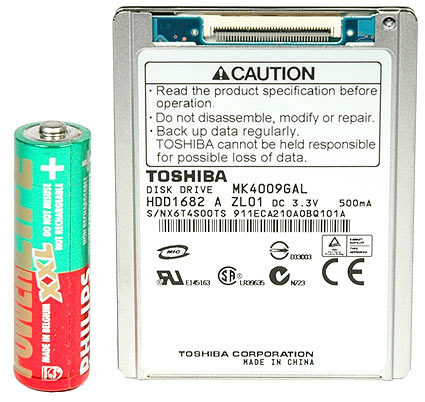1.8" Hard Drives Hit 100 GB
Drive Form Factors: Why 1.8"?
Top to bottom: 1" hard drive (this one is for use as a CompactFlash device), 1.8", 2.5", 3.5".
Different form factors imply various differences in the actual hard drives that use them. Until the late 80s, there used to be 5.25" hard drives for high capacity applications, but the industry moved to smaller platter diameters and form factors for many reasons. First of all there were manufacturing issues, since hard drive platters need to be very rigid and with a perfectly uniform surface. This becomes more important with increasing storage densities and rotation speeds. Obtaining adequate platters is easier to handle for smaller diameters, which increases production yields and even reduces cost. Second, the reduction of platter diameters reduces the rotating mass, which facilitates reaching higher spindle speeds, keeps vibration under control and also helps to reduce energy requirements. The latter is important for systems that have to run multiple hard drives. Third, smaller moving parts translate into less friction and thus less heat dissipation. Finally, access times can be shortened considerably on smaller, higher-RPM platters.
The disadvantage of downsizing hard drive form factors obviously is a reduced surface area, which is where data is stored. The industry found that the 3.5" form factor offers great flexibility, because it allows the building of high-capacity hard drives with three to five platters at up to 7,200 RPM. At the same time, it is possible to deploy the platter technology of 2.5" hard drives into similar 3.5" housings and upgrade all the technology involved - simply put, this is how drive makers create 10,000 RPM and faster drives. This convergence even moved on to hard drive interfaces, as the professional Serial Attached SCSI (SAS) standard also understands the widespread Serial ATA (SATA) protocol. As a consequence, you can install either SATA or SAS 3.5" drives into professional SAS storage products.
While useful in stationary hardware, 3.5" drives are susceptible to shocks, they are relatively heavy and consume a lot of energy. Notebooks and mobile devices require small form factor, low-energy, lightweight devices, which is why notebooks are largely based on 2.5" drives. Ultra-portable computers and many portable consumer electronics devices utilize 1.8" hard drives, because they consume less than half the energy of a 2.5" drive while requiring even less space. If you think of an iPod or a camcorder that stores video data on an integrated hard drive, you'll realize how important smallest-size storage has become.
At this point it is also very important to mention that 1.8" hard drives lose every benchmark to their 2.5" and especially 3.5" brothers. Due to space constraints and a desire to limit power requirements, the fastest rotation speed for 1.8" drive has been 4,200 RPM, and there are still 3,600 RPM drives on the market. The 1.8" drives suffer from the limited rotation speed, as well as from small platter diameters. The larger a platter, the higher the rotation velocity on the outside of the platter (which is why 3.5" drives deliver great transfer rates). Let me give you some numbers: a fast 3.5" drive reaches up to 90 MB/s transfer rate and accesses data in an average of 13 ms. 1.8" drives haven't crossed the 30 MB/s line yet, and can access data within about 20 ms.
There are differences even within one form factor. This image shows two Toshiba 1.8" drives: the left one stores 40 GB on a single platter, while the right one holds 80 GB on two platters (5 mm vs. 8 mm height).
This is a 1.8" hard drive compared to a AA battery.
Get Tom's Hardware's best news and in-depth reviews, straight to your inbox.
1.8" hard drives are small enough to fit in almost every pocket, although they probably aren't robust enough to be carried around in your jeans. The photo above will give you a pretty good impression of their actual size.
Current page: Drive Form Factors: Why 1.8"?
Prev Page Toshiba First At 100 GB Next Page Power Consumption Comparison
Patrick Schmid was the editor-in-chief for Tom's Hardware from 2005 to 2006. He wrote numerous articles on a wide range of hardware topics, including storage, CPUs, and system builds.


